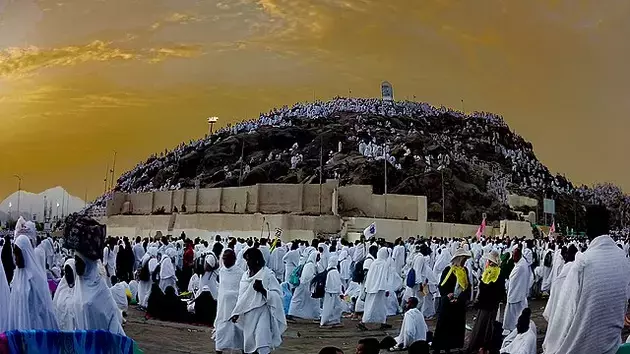Muslims from around the world congregated today at Mount Arafat south of Makkah for the most important day of the Hajj - the day of Arafah.
The ritual at Mount Arafat, known as the hill of mercy, is considered the peak of the Hajj pilgrimage. It is often the most memorable for pilgrims, who stand shoulder to shoulder, feet to feet, asking God for mercy, blessings, prosperity and good health. The mount is about 20 km southeast of Mecca.
It’s believed that Prophet Muhammad delivered his final speech, known as the Farewell Sermon, at the sacred mount 1,435 years ago. In the sermon, the prophet called for equality and unity among Muslims.
Hajj is one of the largest religious gatherings on earth. The rituals officially started Friday when pilgrims moved from Mecca’s Grand Mosque to Mina, a desert plain just outside the city.
The pilgrimage is one of the Five Pillars of Islam. All Muslims are required to make the five-day Hajj at least once in their lives if they are physically and financially able to make the demanding pilgrimage.
The rituals largely commemorate the Quran’s accounts of Prophet Ibrahim, his son Prophet Ismail and Ismail’s mother Hajar - or Abraham and Ismael as they are named in the Bible.
When is the day of Arafah?
The Day of Arafah is on the 9th of Dhul Hijjah, the day before Eid Al Adha. The time of year when the Hajj takes place varies, given that it is set for five days in the second week of Dhu al-Hijjah, the last month in the Islamic lunar calendar.
After Saturday’s worship in Mount Arafat, pilgrims will travel a few kilometers to a site known as Muzdalifa to collect pebbles that they will use in the symbolic stoning of pillars representing the devil back in Mina.
Pilgrims then return to Mina for three days, coinciding with the festive Eid al-Adha holiday, when financially able Muslims around the world slaughter livestock and distribute the meat to poor people. Afterward, they return to Mecca for a final circumambulation, known as Farewell Tawaf.
Once the Hajj is over, men are expected to shave their heads, and women to snip a lock of hair in a sign of renewal. Most of the pilgrims then leave Mecca for the city of Medina, some 340 km away, to pray in Prophet Muhammad’s tomb, the Sacred Chamber. The tomb is part of the prophet's mosque, which is one of the three holiest sites in Islam, along with the Grand Mosque in Mecca and the Al Aqsa Mosque in Jerusalem.






